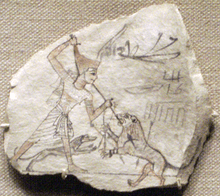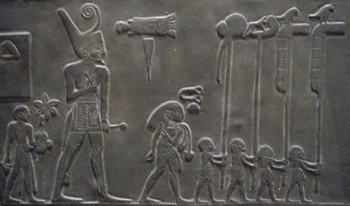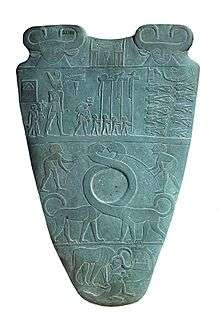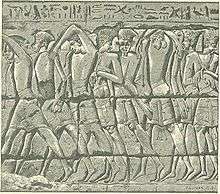Deshret

| ||||
| Deshret, Red Crown (crown as determinative) in hieroglyphs |
|---|
Deshret, from ancient Egyptian, was the formal name for the Red Crown of Lower Egypt and for the desert Red Land on either side of Kemet (Black Land), the fertile Nile river basin. When combined with the Hedjet (White Crown) of Upper Egypt, it forms the Pschent (Double Crown), in ancient Egyptian called the sekhemti.
The Red Crown in Egyptian language hieroglyphs eventually was used as the vertical letter "n" . The original "n" hieroglyph from the Predynastic Period, and the Old Kingdom was the sign depicting ripples of water.
Significance
In mythology, the earth deity Geb, original ruler of Egypt, invested Horus with the rule over Lower Egypt.[1] The Egyptian pharaohs, who saw themselves as successors of Horus, wore it to symbolize their authority over Lower Egypt.[2]
Other deities wore the deshret too, or were identified with it, such as the protective serpent goddess Wadjet and the creator-goddess of Sais, Neith, who often is shown wearing the Red Crown.[3]
The Red Crown would later be combined with the White Crown of Upper Egypt to form the Double Crown, symbolizing the rule over the whole country, "The Two Lands" as the Egyptians expressed it.[4]
As concerns deshret, the Red Land which comprised the deserts and foreign lands surrounding Egypt, Seth was its lord.[5] It was considered a region of chaos, without law and full of dangers.
Records of the Red Crown
None of the red crowns have survived, and it is unknown how it was constructed and what materials were used. Copper, reeds, cloth, and leather have been suggested, but this is purely speculative.
The Red Crown frequently is mentioned in texts and depicted in reliefs and statues. An early example is the depiction of the victorious pharaoh wearing the deshret on the Narmer Palette. A label from the reign of Djer records a royal visit to the shrine of the Deshret which may have been located at Buto in the Nile delta.[6]
The fact that no crown has ever been found buried with any of the pharaohs, even in relatively intact tombs, might suggest that it was passed from one regent to the next, much as in present day monarchies.
Phonogram
| ||
| 1 Red Crown, Deshret 2 also, vertical "N" in hieroglyphs |
|---|
The ancient Egyptian Red Crown, the Deshret crown, is one of the oldest Egyptian hieroglyphs. As an iconographic element, it is used on the famous Narmer Palette of Pharaoh Narmer as the "Red Crown of the Delta", the Delta being Lower Egypt.
|
|
The first usage of the Red Crown was in iconography as the symbol for Lower Egypt with the Nile Delta. Later it came to be used in the Egyptian language – as an alphabetic uniliteral, vertical form for letter "n" as a phoneme or preposition. It became functional in running hieroglyphic texts, where either the horizontal or vertical form preposition satisfied space requirements.
The Red Crown is also used as a determinative, most notably in the word for deshret. It is also used in other words or names of gods.
One older use of the red crown hieroglyph is to make the word: 'in'!, (formerly an-(a-with dot)-(the "vertical feather" hieroglyph a, plus the red crown). Egyptian "in" is used at the beginning of a text and translates as: Behold!, or Lo!, and is an emphatic.
In the 198 BC Rosetta Stone, the 'Red Crown' as hieroglyph has the usage mostly of the vertical form of the preposition "n". In running text, word endings are not always at the end of hieroglyph blocks; when they are at the end, a simple transition to start the next block is a vertical separater, in this case the preposition, vertical n, (thus a space saver).

Since the start of the next hieroglyphic block could also be started with a horizontal "n" at the bottom of the previous block, it should be thought that the vertical "n" is also chosen for a visual effect; in other words, it visually spreads out the running text of words, instead of piling horizontal prepositions in a more tight text. Visually it is also a hieroglyph that takes up more 'space'-(versus a straight-line type for the horizontal water ripple); so it may have a dual purpose of a less compact text, and a better segue-transition to the next words.
The Red Crown hieroglyph is used 35 times in the Rosetta Stone; only 4 times is it used as a non-preposition. It averages once per line usage in the 36 line Decree of Memphis (Ptolemy V)-(Rosetta Stone).
Gallery
-

Ramesside Period ostracon, pharaoh wearing Red Crown
-

Narmer Palette, front
-

The vertical letter N, as preposition, or determinative in the Egyptian language
-

Close-up of Narmer Palette, Pharaoh Narmer with crown
See also
| Wikimedia Commons has media related to Red crown (n hieroglyph). |
| Wikimedia Commons has media related to Red crown. |
- Deshret, the Red Crown of the Pharaoh
- Gardiner's Sign List#S. Crowns, Dress, Staves, etc.
- Gardiner's Sign List
Gallery
-

Ramesside Period ostracon, pharaoh wearing Red Crown
-

Narmer Palette, front
-

The vertical letter N, as preposition, or determinative in the Egyptian language
Deshret (vertical letter N) in hieroglyphic writing
-

-

-

Apep being slain
References
- ↑ Ewa Wasilewska, Creation Stories of the Middle East, Jessica Kingsley Publishers 2000, p.128
- ↑ Toby A. H. Wilkinson, Early Dynastic Egypt, Routledge 1999, p.194
- ↑ George Hart, The Routledge Dictionary Of Egyptian Gods And Goddesses, p.100
- ↑ Ana Ruiz, The Spirit of Ancient Egypt, Algora Publishing 2001, p.8
- ↑ John D. Baines, Byron Esely Shafer, Leonard H. Lesko, David P. Silverman, Religion in Ancient Egypt: Gods, Myths, and Personal Practice, Cornell University Press 1991, p.93
- ↑ Toby A. H. Wilkinson, Early Dynastic Egypt, Routledge 1999, p.284
- Budge. An Egyptian Hieroglyphic Dictionary, E.A.Wallace Budge, (Dover Publications), c 1978, (c 1920), Dover edition, 1978. (In two volumes) (softcover, ISBN 0-486-23615-3)
- Budge. The Rosetta Stone, E.A.Wallace Budge, (Dover Publications), c 1929, Dover edition(unabridged), 1989. (softcover, ISBN 0-486-26163-8)
See also
| Wikimedia Commons has media related to Red crown. |
- Hedjet - White Crown of Upper Egypt
- Pschent - Double Crown of Lower & Upper Egypt
- Atef - Hedjet Crown with feathers identified with Osiris
- Khepresh - Blue or War Crown also called Royal Crown
- Uraeus - Rearing Cobra
- N-water ripple (n hieroglyph)
- Pharaoh-seated, with flail & red crown (hieroglyph)